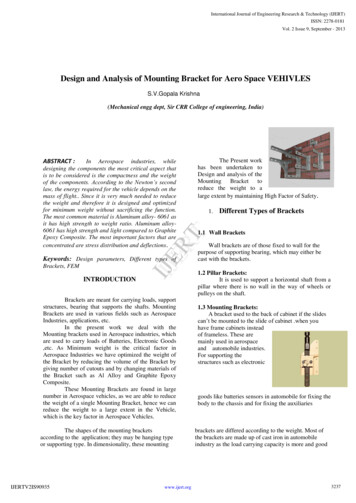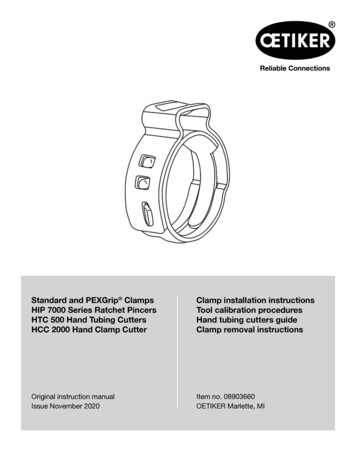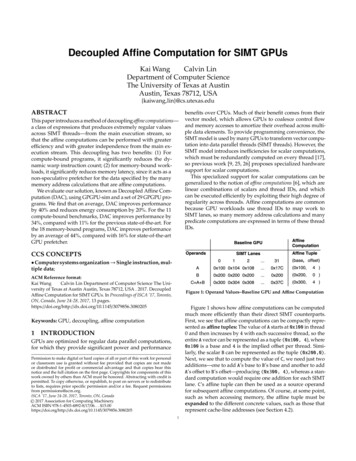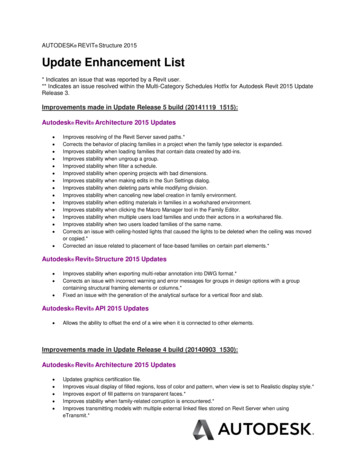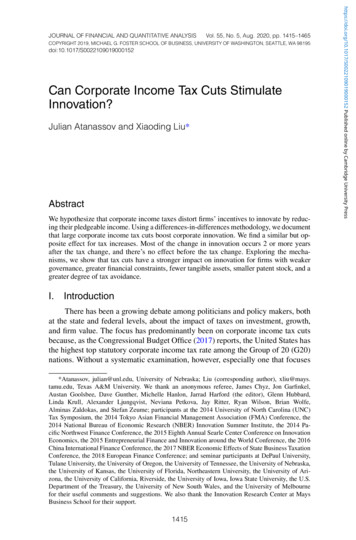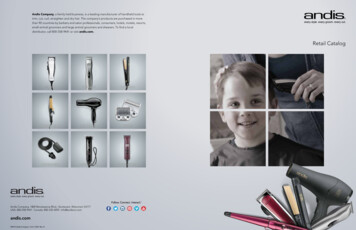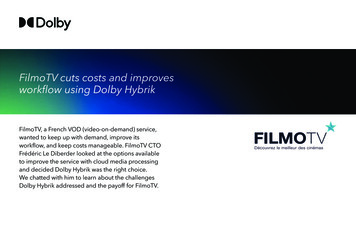
Transcription
FilmoTV cuts costs and improvesworkflow using Dolby HybrikFilmoTV, a French VOD (video-on-demand) service,wanted to keep up with demand, improve itsworkflow, and keep costs manageable. FilmoTV CTOFrédéric Le Diberder looked at the options availableto improve the service with cloud media processingand decided Dolby Hybrik was the right choice.We chatted with him to learn about the challengesDolby Hybrik addressed and the payoff for FilmoTV.
Can you tell us a bit about FilmoTV and what it provides todistributors and viewers?FilmoTV sounds like a movie lover’s dream. What challenges were youlooking to address with Dolby Hybrik cloud media processing?FilmoTV is a VOD and SVOD (subscription-video-on-demand) service launched in2008. We’re distributed in France via all the French ISPs (internet service providers),including Orange, Bouygues Telecom, Free, and SFR. FilmoTV content is availablefor viewing on PCs, mobile phones, and tablets, and through OTT platforms suchas Molotov and Amazon Prime Video. Our focus is movies and our strength hasalways been content curation. We also produce supplementary content, includinginterviews with filmmakers, actors, and behind-the-camera contributors.We first made use of the cloud in 2014, when we needed an encoding solutionthat would fit with our technical architecture. Making this change while keepingthe costs under control was, of course, of great importance for us. But we’re asmall organisation – just 15 of us – and the technical team is just three people. So asolution that offered good support was very important to us.Our TVOD (transactional-video-on-demand, a pay-per-view option) catalogue hasaround 5,000 titles, while the SVOD offering comprises 800 titles, with new filmsadded monthly as older ones are removed. The films come from major distributorssuch as Warner, Universal, 20th Century Fox, Pathé, Gaumont, and StudioCanal, aswell as smaller distributors.Initially, we outsourced encoding. But it really slowed our workflow, both withcommunication back and forth, and simply the need to exchange large files. Costswere high and we had some bad experiences with cheaper solutions that producedlow-quality video files. Dolby Hybrik really turned all that around for us. It’s been agreat experience since Day One.
“Costs were high and we had some bad experienceswith cheaper solutions that produced low-quality videofiles. Dolby Hybrik really turned all that around for us.”MoviesInternal CMS:metadata nFestival EditorProprietary UIISP1Partner 1Partner 2ConformationFilmoGeneric EditorIngestionFilmoTV WebservicesPartner 3Partner 4FilmoGenericQCWEBRaw MaterialPhone/TabletsGame ConsolesHybrikISP2ISP3SmoothISP1ISP2MezzanineISP4
It’s a big step to entrust such an important part of your business toanother company. How did you learn about Dolby Hybrik, and why didyou choose it?I was contacted by Dolby France – by Anaïs Libolt and Benoit Leteneur – who gaveme demo access to the platform. So I was able to see how it would perform for us,before I made a commitment. I was impressed that the Dolby Hybrik team took thetime to learn what FilmoTV needed and discussed the best way to implement theplatform-as-a-service [PaaS] model into our workflow.Dolby Hybrik proved easy to use, and we were able to start integrating it into ourworkflow in a matter of days. The pricing model is also a big plus. The basic cost isquite reasonable – a predictable flat fee – and the dynamic pricing for processing isgreat. We can spin up huge production capacity at a moment’s notice and the costper minute of video processed is so low that even very large jobs are economicallypriced. For a company like FilmoTV – a company that wants to minimise costswithout compromising on quality – it’s the perfect solution.Getting used to a new system can be difficult. Did FilmoTV have tomake a lot of changes or adjustments when you started working withDolby Hybrik?We get movies from the different studios chosen by the distributor. Once we havethe content, the first step is producing a mezzanine file. The specifications of themezzanine file correspond to the specs of the highest-quality format we have toproduce, and often exceeds it by some margin.
“We can spin up huge production capacity at a moment’snotice and the cost per minute of video processed is so lowthat even very large jobs are economically priced.”
From that mezzanine file, we re-encode the file to match the needs of the platformit will appear on. We have to make sure it will play with no problems. For example,for ISPs, we face some tricky requirements due to some constraints they haverelating to their managed networks. Thanks to Hybrik’s flexible approach, and thesupport we got from the technical team at Dolby, we could set up workflows thatcorrespond to these requirements.You didn’t have to make any changes to your workflow to use it?No. If anything, it allowed us to do what we were previously doing, but better.So you didn’t have to completely change how you work?No, we didn’t have to change our approach. And now we’re also looking at usingHybrik to drive further improvements. Not because we have to, but because wesee how adopting these new capabilities could help us. We’re currently extendingthe use of Hybrik to the mezzanine production, and we’ll be transcoding files ondemand rather than storing transcoded files once they’re produced. It’s actuallymore cost-effective, in the long run, to do that. That’s a savings benefit we couldn’tachieve without Dolby.What was the process of integrating Dolby Hybrik into your workflowlike? What was the learning curve?The learning curve was very smooth. We did some test cases and validated themwith the ISPs. The support from Dolby was great. We implemented our workflowstep by step, preparing the encoding profiles for one ISP, then validating it withthe ISP expert, then putting the workflow into production. We didn’t find anythingHybrik couldn’t do – it’s like a Swiss Army knife for video production. Each time weface a technical challenge, Hybrik has the solution.
“Dolby Hybrik team took the time to learn what Filmo TV needed anddiscussed the best way to implement the platform-as-a-service [PaaS]model into our workflow.”How much of your content is produced with Hybrik?We process all our movie catalogue via Hybrik. And all our in-house productions.Has FilmoTV seen real business benefits from making the changeto Dolby Hybrik?Hybrik exceeded our expectations in term of costs and efficiency. We’ve already runthousands of encoding jobs with no problem. Once, we even had to re-encode alarge amount of files requested by a customer, and we did it in just a few days, withno negative impact on the regular work we were doing.Our overall cost for processing has been halved – reduced by 50 per cent. Amazing.And our marginal cost – the cost of processing additional hours of material – hasgone down 90 per cent. We previously had to worry if the cost and the timeinvolved in processing extra hours would be a problem. By using Dolby Hybrik inour workflow, we get both faster processing and reduced costs with no capacitybottlenecks. It’s a success any way you look at it.What does the future hold for FilmoTV and Dolby Hybrik?Are there other capabilities you want to try?Well, we’re not using 100 per cent of Hybrik’s features yet, so we’re going to keepincrementally implementing them to see how they work for us. First up will besome of the automation features, like QC and watch folders. I guess this next roundis a sequel of sorts – one that we at FilmoTV are really looking forward to. We seemany benefits to come.
time to learn what FilmoTV needed and discussed the best way to implement the platform-as-a-service [PaaS] model into our workfl ow. Dolby Hybrik proved easy to use, and we were able to start integrating it into our workfl ow in a matter of days. The pricing model is also a big plus. The basic cost is

